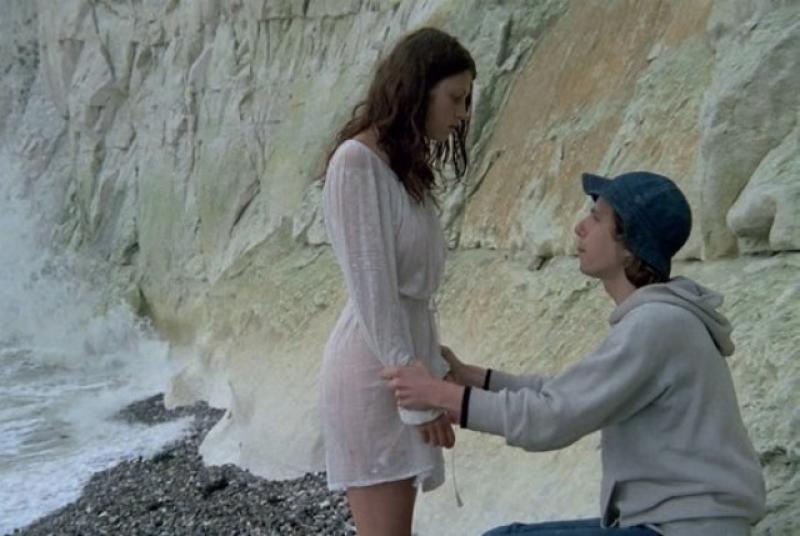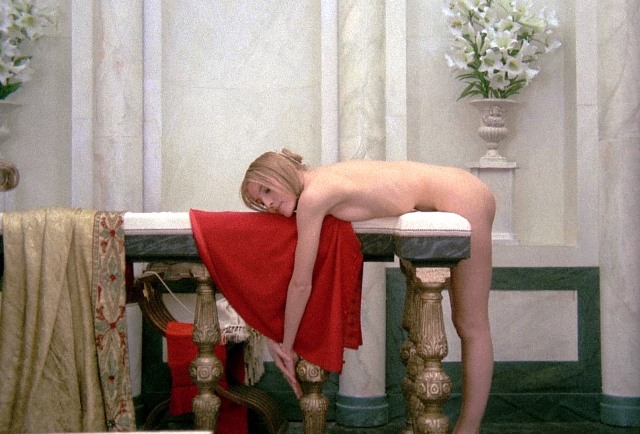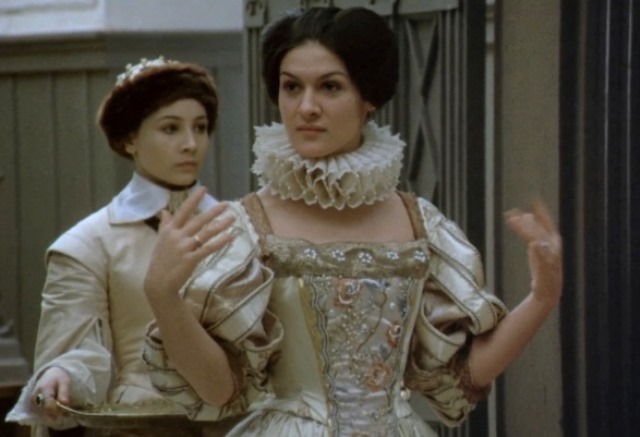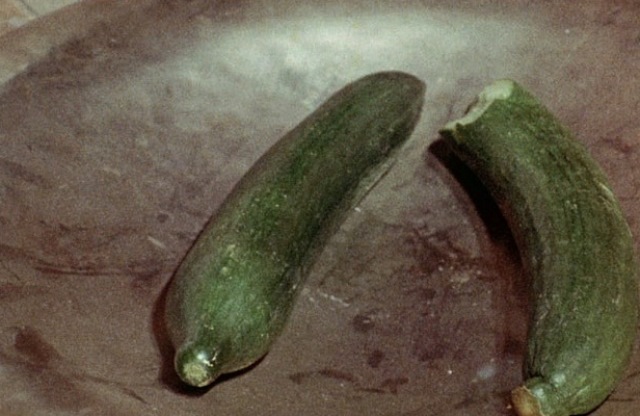Immoral Tales: When Art Met Pornography | reviews, news & interviews
Immoral Tales: When Art Met Pornography
Immoral Tales: When Art Met Pornography
Walerian Borowczyk's controversial, censor-baiting Seventies film is re-released

The release of a restored version of 1974’s Immoral Tales on Blu-ray raises inevitable and unavoidable issues: whether the film is pornography, art or arty pornography. Then, there’s the matter of whether its director Walerian Borowczyk was a misogynist; an objectifier of women. Consideration of its qualities as a film can be lost in such debate.
Borowczyk (1923-2006) was working to the directive of his producer, who suggested he make a film to capitalise on France’s newly relaxed censorship laws. This had the added benefit of also, via its nudity and sexual themes, hopefully attracting more of an audience than his usually niche films. Once delivered, Immoral Tales (Contes Immoraux) became the director’s most successful film to date and set him on the path leading to his stewardship of 1987’s most-certainly unarty Emmanuelle 5.
 After working to order, Borowczyk took the opportunities which came in Immoral Tales’ wake. His next film, his most well-known, was La Bête (The Beast), the subject of a prolonged behind-the-scenes debate in the UK about whether it could be screened due to its tackling of bestiality – albeit fantasy bestiality. A man running around in a costume with an integral and massive penis-like appendage which constantly spewed what looked like sperm was a problem. Especially as he was chasing a woman (pictured right, Florence Bellamy as Lucrezia Borgia).
After working to order, Borowczyk took the opportunities which came in Immoral Tales’ wake. His next film, his most well-known, was La Bête (The Beast), the subject of a prolonged behind-the-scenes debate in the UK about whether it could be screened due to its tackling of bestiality – albeit fantasy bestiality. A man running around in a costume with an integral and massive penis-like appendage which constantly spewed what looked like sperm was a problem. Especially as he was chasing a woman (pictured right, Florence Bellamy as Lucrezia Borgia).
La Bête had developed from an episode filmed for, but not included for release in, the portmanteau, four-episode Immoral Tales. This fifth episode, The True Story of the Beast of Gévaudan, has been added to this wonderfully gleaming Blu-ray restoration which puts any previous home video editions in the shade.
Identifiably a Borowczyk film, Immoral Tales was, whatever its envelope-pushing content, at one with the director’s output to date. Film was one aspect of his oeuvre. Born in Poland, he had arrived in France in 1958 and fell in with a cinematic set which included Chris Marker. Borowczyk was also a poster artist, animator, author and sculptor – all of which ended up in and informed his films. Pre-Immoral Tales, he anticipated the Brothers Quay and Jan Švankmajer with his animated works. Borowczyk’s use of set design to depict a world prefigured Lars von Trier’s Dogville. A pioneer, Borowczyk blurred the margins between disciplines – with which Immoral Tales’ boundary-breaking was in keeping. Above all, though, he was a fantasist.
 With Immoral Tales he ended up with – at least in France – the desired wider if thrill-seeking audience. Notably, it was the only film to feature Paloma Picasso, the artist’s daughter. But that was a side issue. No doubt most of the attraction was the female nudity – including that of Ms Picasso – and depictions of non-traditional sexual situations. Borowczyk was particularly keen on close shots of female pubic hair (pictured left, Paloma Picasso as Erzsébet Báthory).
With Immoral Tales he ended up with – at least in France – the desired wider if thrill-seeking audience. Notably, it was the only film to feature Paloma Picasso, the artist’s daughter. But that was a side issue. No doubt most of the attraction was the female nudity – including that of Ms Picasso – and depictions of non-traditional sexual situations. Borowczyk was particularly keen on close shots of female pubic hair (pictured left, Paloma Picasso as Erzsébet Báthory).
Based on literary sources, the four episodes concerned unusual takes on differing scenarios: fellatio, masturbation, lesbianism and incest. Overall, it comes across now as if Luis Bunuel had decided to make a historical-type film with heaps of naked women. There is a mischievous quality, and the late Ken Russell may have recognised a fellow traveller.
Erzsébet Báthory, the episode with Picasso, is about the countess who bathes in blood to preserve her youth. It is intense and plays like a fever-dream take on Pasolini. Despite the theme of incest, the Lucrezia Borgia episode verges on slapstick. The two weakest episodes are the dull Thérèse Philosophe (religious fervour-inspired masturbation with a cucumber) and the silly La Marée (The Tide), where 16-year-old Julie’s cousin attempts to synchronise his coming in her mouth with the time of high tide – they are swallowed by the rising tide while she swallows his sperm. She is seen naked. He is not; his penis is out of sight.
 As for whether this patchy film was pornography, it is clearly exploitation cinema – but it is not titillating. And with a prime purpose of serving its scenarios, Immoral Tales also fails the porn test. Indeed, for Sight & Sound in 1977, this was art: Borowczyk’s “Immoral Tales are compiled from a succession of such ‘erotic’ images as gulls, candlesticks, tapestries, breasts, jewels, lace, rough wood and tangled triangles of hair.”
As for whether this patchy film was pornography, it is clearly exploitation cinema – but it is not titillating. And with a prime purpose of serving its scenarios, Immoral Tales also fails the porn test. Indeed, for Sight & Sound in 1977, this was art: Borowczyk’s “Immoral Tales are compiled from a succession of such ‘erotic’ images as gulls, candlesticks, tapestries, breasts, jewels, lace, rough wood and tangled triangles of hair.”
Nevertheless Borowczyk did objectify some of the women in the film (especially those sacrificed in Erzsébet Báthory), but in his art he objectified everything. If he was a misogynist, more evidence than Immoral Tales would be needed to prove the case. The film is best approached as a wonky, art-house entry in the fantastic cinema canon (pictured right, cucumbers in the Thérèse Philosophe episode).
This version is 103 minutes: four longer than previous releases. Extras include another cut of the film, two versions of the short film A Private Collection, an introduction, interviews with those involved in the film (no archive footage of Borowczyk) and its trailer.
Immoral Tales is accompanied into the shops this week by four other Borowczyk Blu-ray releases: The Beast (1975), Blanche (1971), Goto, Isle of Love (1968) and the collection Short Films and Animation (12 shorts from 1958 to 1984 and three commercials). Each includes copious extras, commentaries and interviews and look as fantastic as Immoral Tales. The limited-edition box set Camera Obscura: The Walerian Borowczyk Collection, released at the same time, included all these but has already sold out.
All of which begs the question: who is going to take on the job of making the rest of Borowczyk’s film work available?
Explore topics
Share this article
The future of Arts Journalism
You can stop theartsdesk.com closing!
We urgently need financing to survive. Our fundraising drive has thus far raised £33,000 but we need to reach £100,000 or we will be forced to close. Please contribute here: https://gofund.me/c3f6033d
And if you can forward this information to anyone who might assist, we’d be grateful.

Subscribe to theartsdesk.com
Thank you for continuing to read our work on theartsdesk.com. For unlimited access to every article in its entirety, including our archive of more than 15,000 pieces, we're asking for £5 per month or £40 per year. We feel it's a very good deal, and hope you do too.
To take a subscription now simply click here.
And if you're looking for that extra gift for a friend or family member, why not treat them to a theartsdesk.com gift subscription?
more Film
 theartsdesk Q&A: Raoul Peck, director of the documentary 'Ernest Cole: Lost and Found'
Peck analyses his approach to the anti-apartheid photographer's work and to his methods as a political filmmaker
theartsdesk Q&A: Raoul Peck, director of the documentary 'Ernest Cole: Lost and Found'
Peck analyses his approach to the anti-apartheid photographer's work and to his methods as a political filmmaker
 Blu-ray: The Barnabáš Kos Case
Witty and stylish Slovak black comedy, alarmingly prescient
Blu-ray: The Barnabáš Kos Case
Witty and stylish Slovak black comedy, alarmingly prescient
 Bonhoeffer review - flawed biopic of a saintly man of courage
This film about the pastor accused of conspiring in the Hitler assassination plot raises more questions than it answers
Bonhoeffer review - flawed biopic of a saintly man of courage
This film about the pastor accused of conspiring in the Hitler assassination plot raises more questions than it answers
 Twiggy review - portrait of a supermodel who branched out
The face of 1966: Sadie Frost's documentary captures Twiggy's extraordinary versatility
Twiggy review - portrait of a supermodel who branched out
The face of 1966: Sadie Frost's documentary captures Twiggy's extraordinary versatility
 On Falling review - human cogs in a merciless machine
Mesmerising drama about a gig economy worker at the end of her tether
On Falling review - human cogs in a merciless machine
Mesmerising drama about a gig economy worker at the end of her tether
 theartsdesk Q&A: Oscar-winner Adrien Brody on 'The Brutalist'
The much-garlanded actor on what playing the architect László Toth meant to him
theartsdesk Q&A: Oscar-winner Adrien Brody on 'The Brutalist'
The much-garlanded actor on what playing the architect László Toth meant to him
 Blu-ray: The Texas Chainsaw Massacre 2
Tobe Hooper's grisly, blackly comic sequel patents a surreal Texas zone all its own
Blu-ray: The Texas Chainsaw Massacre 2
Tobe Hooper's grisly, blackly comic sequel patents a surreal Texas zone all its own
 Oscars 2025: long day's journey into 'Anora'
'Anora' creator Sean Baker wins four trophies in a night full of firsts - and a second trophy for Adrien Brody
Oscars 2025: long day's journey into 'Anora'
'Anora' creator Sean Baker wins four trophies in a night full of firsts - and a second trophy for Adrien Brody
 The Last Showgirl review - Pamela Anderson stars as a middle-aged Vegas dancer
Gia Coppola's third feature is atmospheric but disappointing
The Last Showgirl review - Pamela Anderson stars as a middle-aged Vegas dancer
Gia Coppola's third feature is atmospheric but disappointing
 Blu-ray: Drugstore Cowboy
Gus Van Sant's non-judgmental indie classic about a gang of narcotics addicts
Blu-ray: Drugstore Cowboy
Gus Van Sant's non-judgmental indie classic about a gang of narcotics addicts
 The Monkey review - a grisly wind-up
Oz Perkins’ Longlegs follow-up plays Stephen King's killer toy for bloody laughs
The Monkey review - a grisly wind-up
Oz Perkins’ Longlegs follow-up plays Stephen King's killer toy for bloody laughs

Add comment